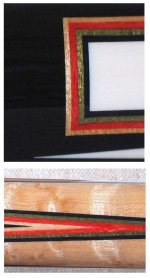Several months ago I bought a camera and I think it's quite suitable for taking cue pictures. This camera is Panasonic DMC-LX2. You can read more information about this camera in
http://www.dpreview.com/reviews/panasoniclx2/
I recommend this camera for several reasons:
1) It is with Leica DC lens, and able to bring very good colors. Acutally Panasonic ODM this model for Leica D-Lux 3.
2) It supports the 16:9 mode to be suitable to take pictures for long objects, like cues.
3) 10MP to capture the detail. Very important in cue photos.
This picture shows the advantage of the 16:9 ratio. I didn't crop it, only resized it.
It can show the BEM grain very clearly.
You can derive a lot of details if you take pictures in 10MP capture. I resized the original pictures to 800x600, but I cropped some details in their original size.
In first example, you can see the windows were built in stacked way. In second example you can see the glue lines of the tiny ivory diamonds.
All the pictures are only resized and retained original. I believe they would look even better if I did some post processing with a proper image editor. The LX2 is not a DLSR, but if you prefer a small-sized consumer DC I would recommend this one very much.
By the way, the LX2 supports high ISO up to 3200. But I would say the image quality is quite bad if you set the ISO greater than 400. Better to take pictures with good lighting.







